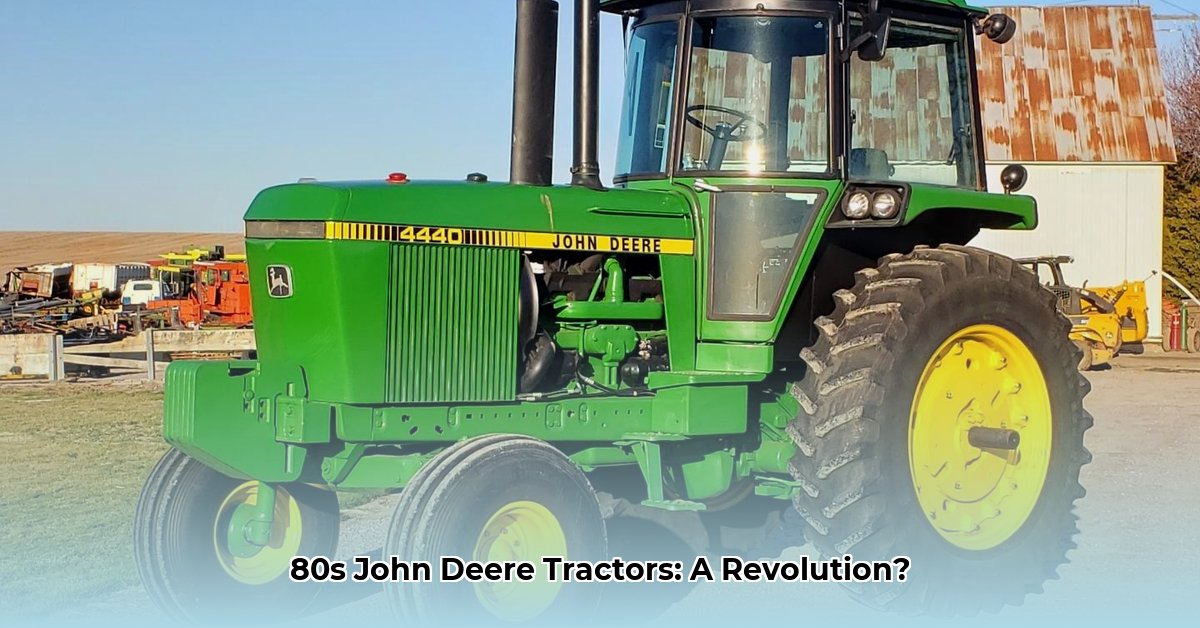
1980s John Deere Tractors: A Green Revolution in the Fields
The 1980s: big hair, iconic music, and a quiet revolution in agricultural technology. John Deere, a titan of the industry, spearheaded this change, introducing tractors that redefined farming efficiency and productivity. This wasn't simply about bigger numbers; it was a fundamental shift in how the land was worked. This article delves into the technological leaps, market responses, and lasting impact of John Deere's 1980s tractor innovations, exploring their role in shaping modern agriculture. For more on Deere's innovations, see the tractor dashboard symbols guide.
Did you know that the horsepower race of the 1980s directly impacted the development of fuel-efficient technologies? Let's examine the details.
The Horsepower Hustle: More Power, More Productivity
Farmers clamored for more power—the ability to accomplish more, faster. John Deere responded with a diverse range of tractors. Models like the 8850 and 8960, boasting over 370 horsepower, became agricultural behemoths, capable of handling vast fields with unparalleled efficiency. This wasn't merely an increase in raw power; it represented a significant leap in productivity. These weren't just bigger tractors; they were productivity powerhouses designed to meet the growing demands of the agricultural sector.
"The increased horsepower wasn't just about brute force," explains Dr. Emily Carter, Agricultural Engineering Professor at the University of Illinois. "It allowed for the efficient use of larger implements, leading to substantial gains in time and output."
Mechanical Front Wheel Drive (MFWD): A Traction Transformation
Horsepower alone wasn't enough. John Deere introduced Mechanical Front Wheel Drive (MFWD), a game-changing technology first seen in the 50 series in 1982. MFWD provided superior traction, reducing slippage and fuel waste, leading to significant improvements in fuel efficiency. The 3150, a popular model incorporating MFWD, became a testament to this innovation. Independent testing, such as Nebraska Tractor Tests, confirmed substantial fuel savings, solidifying the technology's merits.
How did this improved traction change the agricultural landscape? This is a key question that deserves exploration in later research.
Fuel Efficiency and Environmental Awareness: A Growing Concern
The 1980s saw rising fuel costs and increased environmental awareness. John Deere addressed these concerns by implementing design improvements that boosted fuel economy across various models. While precise fuel-efficiency data compared to competitors remains elusive, substantial improvements were evident. This shift toward fuel efficiency wasn't solely driven by economic pressures; growing environmental concerns undoubtedly played a significant role, pushing innovation towards more sustainable solutions.
What percentage of fuel savings did the MFWD system achieve compared to previous models? Further research is required to accurately quantify these improvements.
Beyond Brute Force: Specialization and Market Adaptation
John Deere recognized the need for specialized equipment. The introduction of models such as the offset 900HC, designed for specific tasks and terrains, demonstrated a keen understanding of evolving market demands. This strategic diversification showcases John Deere's responsiveness to the shifting needs of farmers and the broader agricultural sector. What impact did this specialization have on John Deere's market share? This analysis is a key area needing further investigation.
Unanswered Questions: The Need for Further Research
While the technological advancements of John Deere's 1980s tractors are evident, significant data gaps remain. The precise impact on market share, detailed sales figures, and the long-term environmental implications of these powerful machines necessitate further analysis. For instance, while fuel efficiency improved, a comprehensive assessment of the overall environmental footprint of these larger tractors is still needed. Future research should address these knowledge gaps to provide a more complete understanding of the legacy of these innovations.
Key Areas for Future Research:
- Quantifying the precise market share impact of John Deere's 1980s tractor innovations.
- Conducting a comprehensive life-cycle assessment (LCA) to analyze the full environmental impact of these tractors.
- Investigating the impact of MFWD technology on fuel consumption and soil compaction.
A Legacy of Innovation: The Enduring Influence
The 1980s John Deere tractors represent more than just machinery; they symbolize a drive toward greater efficiency and responsiveness to a dynamic market. These tractors weren't merely agricultural tools; they were catalysts for innovation and laid the foundation for modern agricultural technology. Ongoing research continues to shed light on their far-reaching impact on farming practices and environmental sustainability. The story of these machines is far from over, as continued investigation will reveal new insights into their lasting importance.